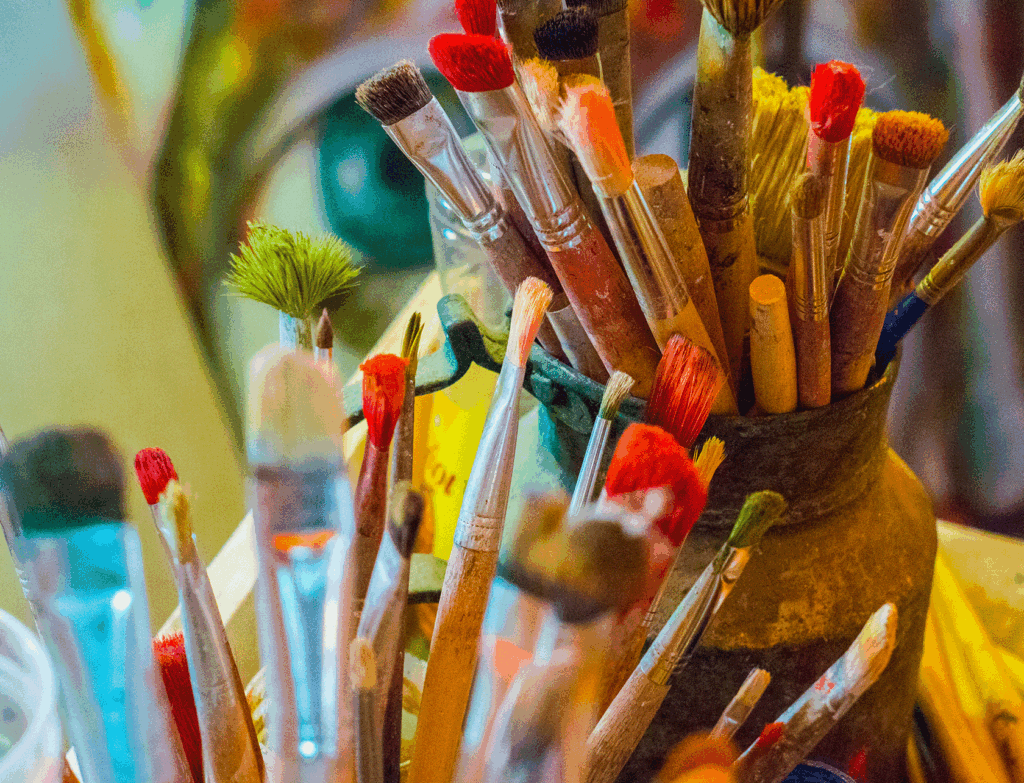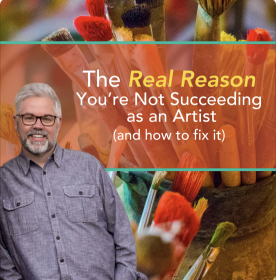In a world saturated with creative content, developing a distinctive artistic voice isn’t just helpful—it’s essential. But here’s the thing: your unique voice isn’t some mystical quality that either strikes like lightning or remains forever elusive. It’s built through intentional design choices that become your creative DNA.
Beyond the “Squishy and Ethereal”: Making Voice Tangible
Too often, we talk about artistic voice in vague terms—”balance,” “harmony,” “style.” But these concepts only become powerful when we can identify the specific, replicable elements that create them. When you can look at ten pieces of your work lined up and see not only consistency within each piece but also consistency between pieces, that’s when you know you’re developing a true artistic voice.
The Five Pillars of Distinctive Design
1. Intentional Repetition: Your Visual Vocabulary
Repetition isn’t about being boring—it’s about creating a visual language that speaks fluently about who you are as an artist. This means:
- Consistent use of specific elements (textures, shapes, forms)
- Repeated compositional approaches that feel natural to you
- Signature techniques that appear across multiple works
The key is making these repetitions feel organic, not forced. When elements naturally echo throughout your work, viewers begin to recognize your “handwriting” before they even see your signature.
2. Cohesive Color Relationships: Your Emotional Palette
Many distinctive artists work within deliberately limited color palettes. This isn’t a restriction—it’s a superpower. A cohesive color approach:
- Creates immediate visual unity across your body of work
- Allows you to master subtle variations within familiar territory
- Builds emotional consistency that viewers can connect with
- Makes your work instantly recognizable in any setting
Consider how your color choices reflect your personality, your environment, or your emotional response to the world.
3. Strategic Contrast: The Art of Visual Hierarchy
Effective contrast isn’t just about light versus dark—it’s about creating intentional focal points that guide the viewer’s eye exactly where you want it to go. This includes:
- Value contrast (light against dark)
- Textural contrast (smooth against rough)
- Scale contrast (large elements supporting smaller details)
- Conceptual contrast (simple backgrounds supporting complex focal points)
The magic happens when your contrast choices become predictable in the best way—viewers learn to trust that you’ll take them on a visual journey.
4. Compositional Flow: Your Unique Movement Language
Every artist develops a particular way of moving the eye through their work. This might be:
- Circular movements that bring viewers back to center
- Linear progressions that create narrative flow
- Radial patterns that explode outward from focal points
- Layered depths that invite extended exploration
Your compositional preferences reveal how you see and experience the world—and become part of your artistic signature.
5. Textural Consistency: The Physical Language of Your Materials
Whether you work in paint, clay, fiber, or mixed media, you likely have instinctive preferences for:
- Surface qualities (smooth, rough, layered, weathered)
- Tool marks and application methods
- Levels of detail versus simplicity
- Ways of building up or carving away
These physical choices become as distinctive as handwriting, creating tactile recognition even in photographs of your work.
The Development Process: From Intuition to Intention
Here’s what many artists don’t realize: you probably already have the beginnings of a unique voice—you just haven’t recognized and refined it yet. The development process involves:
Step 1: Recognition Look at your last 10-20 pieces. What elements keep showing up? What color combinations do you gravitate toward? What compositional approaches feel most natural?
Step 2: Intentional Repetition Once you identify your natural tendencies, begin using them more deliberately. If you naturally create circular compositions, explore that fully rather than fighting it.
Step 3: Systematic Refinement Treat each new piece as an opportunity to refine your visual vocabulary. Ask: “How can this piece strengthen the consistent elements that make my work recognizable?”
Beyond Copying: The Difference Between Influence and Imitation
Developing your voice doesn’t mean working in isolation. The goal isn’t to create something never seen before—it’s to filter everything through your unique perspective and preferences. When you see work that resonates with you, ask:
- What specific design elements create that effect?
- How could I achieve something similar using my own visual vocabulary?
- What would this approach look like filtered through my color preferences, my compositional style, my material choices?
The Long Game: Building Recognition Over Time
A distinctive artistic voice isn’t built overnight. It emerges through:
- Consistent practice within your chosen parameters
- Gradual refinement of your signature elements
- Confident commitment to your natural preferences
- Thoughtful evolution rather than constant reinvention
Your Voice as Your Competitive Advantage
In our connected world, technical skill alone isn’t enough. Viewers are drawn to work that feels authentic, consistent, and emotionally resonant. When your artistic voice is strong and clear:
- Collectors know what to expect from you
- Your work becomes more memorable and shareable
- You can command higher prices for your unique perspective
- You build genuine connection with your ideal audience
The Permission to Be Yourself
Perhaps the most important element of developing your artistic voice is giving yourself permission to embrace what comes naturally. Your voice isn’t hiding somewhere “out there”—it’s already emerging in the choices you make instinctively.
The question isn’t “What should my artistic voice be?” It’s “What is my artistic voice trying to become, and how can I support that development?”
Your artistic voice is your creative fingerprint—unique, valuable, and entirely yours. By paying attention to the specific design elements that feel most authentic to you and developing them with intention, you create work that doesn’t just look good—it looks unmistakably like you.
Ready to Develop Your Voice AND Build a Thriving Art Business?
Finding your artistic voice is just the beginning. What if you could also learn how to:
- Turn your unique creative gifts into sustainable income
- Build genuine relationships with collectors who love your work
- Develop the business systems that support your art (without compromising your creativity)
- Connect with other Kingdom artists who are serious about their calling
- Get practical, proven strategies for commissions, galleries, and online sales
The Created to Thrive Artist Mentoring Program provides the complete roadmap for artists who want to flourish both creatively and financially. You’ll get access to:
- Step-by-step business training specifically designed for artists
- A supportive community of like-minded creatives
- Regular coaching calls and expert guidance
- Proven systems for everything from pricing to client relationships
- Resources for growing in your creative calling as an artist in the Kingdom
This isn’t just about making money from your art—it’s about stewarding your gifts well and building the life and business that allows your creativity to thrive.
Ready to take the next step in your artistic journey?
Join the Created to Thrive Artist Mentoring Program and discover how to develop both your unique voice and a business that supports your creative calling.
Your artistic voice is already emerging. Now let’s help you build a thriving art business around it.



Leave a Reply